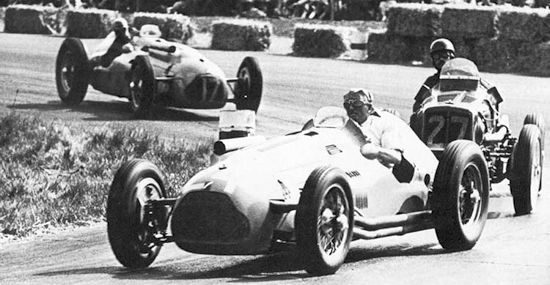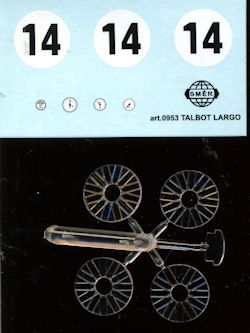
Atlantis 1/24 Alfa Romeo and Talbot-Lago F.1 cars
| KIT #: | AMC-6001 |
| PRICE: | $39.95 SRP |
| DECALS: | One option each |
| REVIEWER: | Scott Van Aken |
| NOTES: | Reboxed SMER kits which are reboxed Merit kits. |

| HISTORY |
Italian born Anthony F.
Lago took control of the ailing SA Automobiles Talbot in 1935 after the joint
venture between Sunbeam, Talbot and Darracq had failed. Lago was a big fan of
motor racing and believed that success on the track was the best marketing tool
for the company's road going products. Using the existing three litre six
cylinder Talbot as a base, Lago and ex-Fiat designer Walter Becchia developed a
new four litre competition engine. The engine used Talbot's patented valvetrain,
which used a single camshaft to operate the 60-degree inclined valves through 12
unequal length pushrods. The four litre engine debuted in a roadster bodied
racer in 1936, and would also go on to power the legendary Figoni & Falashi
teardrop-coupes. Excelling in reliability these racers scored several sportscar
and Grand Prix victories.
After a seven year hiatus production recommenced in Suresnes in 1947. Helped by
a new designer, Carlo Marchetti, Lago developed a 4.5 litre version of the
familiar six cylinder engine, which was first raced in the late 1930s. One of
the incentives to increase the engine's displacement was to meet the
displacement limit for unblown Grand Prix engines; blown engines were limited to
1.5 litres. With 165 bhp the 4.5 litre 'six' was not going to be a match for the
300+ bhp supercharged engines used in the German and Italian single seaters, so
Lago and Marchetti went back to the drawing boards and designed a revised head
for the 4.5 litre engine during the War. Their new engine made its debut in the
T26 road car range launched in 1947. The competition version followed
shortly after.
Reminiscent of the old Riley engines, the new six cylinder engine Lago and
Marchetti came up with had two lateral camshafts halfway up the block. Simpler
in design and execution than a full overhead camshaft design, the lateral
camshafts did share many of the advantages. Short pushrods were used to operate
the 12 valves. In its initial guise the engine was good for a reported 240 bhp,
while the twin-plug version introduced in 1950 was officially quoted at 260 bhp.
The straight six was mated to a four speed Wilson preselector gearbox. This
drivetrain was installed in a straightforward box section chassis. Suspension
was by wishbones and a transverse leaf spring at the front and a solid axle at
the rear. Both the chassis and the gearbox were directly derived from the 1930s
Talbot Lago racers and also similar to the company's contemporary road cars.
Huge drums provided for some braking power.
 Dubbed
the T26C, the new single seater Talbot Lago made its competition debut in the
1948 Monaco Grand Prix. Compared to the supercharged competition from Alfa
Romeo, Ferrari and Maserati, the French cars looked obsolete before they even
turned a wheel in anger. Maserati's two-stage supercharged 4CLTs outran the
Talbots with ease, but in the race the odds were evened out. Whereas the
Italians required at least one pit stop to refuel and fit new tires, the T26C
could complete the race without ever stopping. Despite stopping halfway for fuel
Nino Farina took the victory for Maserati, but with Louis Chiron in a T26C hot
on his heels. Thanks to its superior mileage and reliability the T26C scored two
major Grand Prix victories in 1949. Reportedly the victory at Spa Francorchamps
convinced Enzo Ferrari to abandon his supercharged V12 racers in favour of a new
4.5 litre naturally aspirated cars.
Dubbed
the T26C, the new single seater Talbot Lago made its competition debut in the
1948 Monaco Grand Prix. Compared to the supercharged competition from Alfa
Romeo, Ferrari and Maserati, the French cars looked obsolete before they even
turned a wheel in anger. Maserati's two-stage supercharged 4CLTs outran the
Talbots with ease, but in the race the odds were evened out. Whereas the
Italians required at least one pit stop to refuel and fit new tires, the T26C
could complete the race without ever stopping. Despite stopping halfway for fuel
Nino Farina took the victory for Maserati, but with Louis Chiron in a T26C hot
on his heels. Thanks to its superior mileage and reliability the T26C scored two
major Grand Prix victories in 1949. Reportedly the victory at Spa Francorchamps
convinced Enzo Ferrari to abandon his supercharged V12 racers in favour of a new
4.5 litre naturally aspirated cars.
In the following seasons the sturdy Talbots scored a large number of victories
in non-Championship races and proved to be a popular pick for privateer racers.
Convinced of the car's reliability, Anthony Lago prepared a T26C for the 1950 24
Hours of Le Mans. Keeping the modifications to a bare minimum, he simply fitted
fenders, lights and a slightly wider body to accommodate for two drivers. All of
which were required only to comply with the regulations. Piloted by Louis Rosier
and Jean-Louis Rosier, the Grand Prix car turned endurance racer scored its most
notable victory. In the next edition, a similar car finished second, but well
beaten by the much more modern Jaguar C-Type. More cars were built along the
lines of the Le Mans racer and some were even fitted with more substantial coupe
bodies.
The Talbot Lago T26C remains as one of the last 'old-fashioned' racers that
could win in Grand Prix sprint races and in the most demanding endurance events.
On top of the T26C's Grand Prix and Le Mans wins, it scored many successes in
minor and local races.
| THE KIT |
 Just
like I've not provided any background to the Alfa Romeo also included in this
box, I'll skip any of the details of the kit as well. This is because Mark Hiott
pretty well covered it all in his very nice build of the Alfa Romeo (see the kit
index).
Just
like I've not provided any background to the Alfa Romeo also included in this
box, I'll skip any of the details of the kit as well. This is because Mark Hiott
pretty well covered it all in his very nice build of the Alfa Romeo (see the kit
index).
As mentioned in the notes, this is the SMER kit and comes with SMER instructions. The kit itself was initially released by MERIT and it may even be a 1950s vintage. MERIT did a bunch of neat F.1 subjects and I'm hoping that some others may see the light of day. Anyway, the Talbot kit is molded in a nice blue color and despite the age of the kits, the molding is truly excellent. There is a tiny bit of flash, but nothing like what you might expect and it is quite minimal. Overall detail of the kit is actually quite good and is of the raised line type.
The kit comes with a complete engine that includes a
radiator, but since it sits in a pretty empty engine compartment, one may wish
to add wiring and some other bits to spruce it up. The front and rear suspension
sections are also well done and appear quite sturdy. The plastic wheels have
clear 'wire' inserts, which, while not as convincing as photo etch, should look
good enough. Each of the wheels is
 held on by
a two-prong knock-off hub that is glued to the axle to allow the wheel to turn.
The nicely molded exhaust is the piece that has the most flash on it and again,
it isn't much. The in
held on by
a two-prong knock-off hub that is glued to the axle to allow the wheel to turn.
The nicely molded exhaust is the piece that has the most flash on it and again,
it isn't much. The in terior
is fairly well appainted with pedals, instrument panel, steering wheel
seat and so on. These guys did not wear seat belts so no need to add them. There
are decals for the instruments.
terior
is fairly well appainted with pedals, instrument panel, steering wheel
seat and so on. These guys did not wear seat belts so no need to add them. There
are decals for the instruments.
Instructions are rather nicely done with well thought out construction steps. There is NO painting information anywhere so you are on your own in this regard. Restored cars show a black interior with a turned aluminum dash with the seat padded in some sort of black leather material. No exterior painting information is supplied either. One will have to rely on photos of restored cars or the box illustrations for color and placement info. In this case, the Talbot is actually a French blue color, though the artwork and even the interior photo might have you think it is a bluish silver color due to the lighting. The small decal sheet is very nicely printed and I'll bet they are Propagteam or similar decals.
| CONCLUSIONS |
OK, so you might think that $40 is a bit much to pay for kits that probably sold for less than a dollar or two when new. Welcome to the 21st Century where even ancient kits sell for a rather high price. If you think about it, it is still only about $20 each and you'll get fresh decals along with it. These should be a pretty nice build and not ones that will cause a lot of headaches. For one thing, there is plenty of room to add stuff to it if you are so inclined and they'll look nice on your shelf.
| REFERENCES |
The internet.
2014 Thanks to me for picking up the preview kit.
If you would like your product reviewed fairly and fairly quickly, please
contact
the editor or see other details in the
Note to
Contributors.